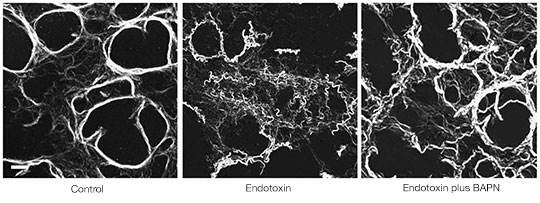New insight about blood vessel function could lead to novel therapies for lung diseases caused by acute respiratory distress syndrome, sepsis, smoke inhalation, traumatic injury, and more

A drug that softens the extracellular matrix, the molecular scaffold that knits cells together into tissues, may ease pulmonary edema, a life-threatening condition caused by fluid filling the air sacs of the lung, a team from Boston Children’s Hospital and the Wyss Institute for Biologically Inspired Engineering at Harvard University reported last week in Nature Communications.
"The study changes the way we think about how tissues are regulated," says Don Ingber, M.D., Ph.D., Founding Director of the Wyss Institute and senior investigator on the study. "The most exciting thing is that it opens up an entirely new range of targets for therapy."
For many years most biologists believed that the extracellular matrix was just "a dumb glue that holds things together," Ingber says. But over the last 30 years, research by Ingber and others has revealed that it controls whether cells multiply, where they migrate, how they function, even whether they live or die.
Earlier studies had suggested that the matrix’s mechanical properties — whether it’s stiff, as in bone, or flexible, as in skin — influences the behavior of the cells it holds together. But those studies were done in lab-grown cells, and it wasn’t clear whether the same was true in living tissues and organs.
To find out if it was, Akiko Mammoto, M.D., Ph.D., Instructor in Surgery at Harvard Medical School and the Vascular Biology Program of Boston Children’s Hospital, tested what happened to the lungs of mice after she softened their extracellular matrix with a drug called BAPN, or stiffened it through genetic engineering. She saw that either change disrupted the tight seals between the cells in the capillary walls, and both treatments turned healthy capillaries into sieves.
"This was a total surprise," Ingber says. Mammoto and Ingber wondered whether toxins from disease-causing bacteria harmed the cell by changing the extracellular matrix.
During severe infections, bacteria release a toxin called endotoxin that causes severe whole-body inflammation, or sepsis. In some patients, sepsis makes lung capillaries leaky, allowing enough fluid into the air sacs to cause pulmonary edema. Some patients with pulmonary edema develop acute respiratory distress syndrome (ARDS), which severely compromises lung function. Sixty percent of those patients die, and no drugs exist to treat the condition.
When Mammoto treated mice with endotoxin, their lung capillaries became 35 percent stiffer and four times leakier than those of untreated mice. This suggested that endotoxin disrupted lung function by making the matrix more rigid. When she then treated the mice with BAPN, the matrix-softening drug, the animals’ capillaries remained intact in the presence of the toxin, thereby preventing pulmonary edema.
In the clinic, this new treatment strategy could be combined with current, palliative care for sepsis. "If we can combine BAPN or a related molecule with current therapies, maybe we can treat ARDS," Mammoto says.
More broadly, Ingber concludes, the results "open up a pathway you’d never have seen if you didn’t think of mechanical forces as informative signals."